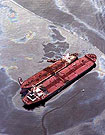A detailed study of Prince William Sound has found that few traces of the Exxon Valdez oil spill remain in the marine environment and are causing little, if any, harm to sea otters and other wildlife. Scientists collected 700 samples from 25 sites most heavily contaminated by the spill, which released 10.8 million
 gallons of crude oil into the pristine sound when the Exxon Valdez hit a reef in 1989. Researchers found only remnant patches of degraded oil deep in cracks among rocks and said the oil was not being ingested by sea birds or animals. Sea otters have returned to two of the most polluted beaches, the study said. The findings, published in the journal Environmental Science and Technology, do not mean that the spill did not cause lasting damage, as it killed an estimated 250,000 to 500,000 seabirds, 1,000 sea otters, and other creatures. Local killer whale populations still have not recovered. Exxon Mobil has spent nearly $1 billion studying the impact of the spill and paid for the current study, which was conducted by university research scientists and a scientific consultant. Independent scientists concurred with the findings.
gallons of crude oil into the pristine sound when the Exxon Valdez hit a reef in 1989. Researchers found only remnant patches of degraded oil deep in cracks among rocks and said the oil was not being ingested by sea birds or animals. Sea otters have returned to two of the most polluted beaches, the study said. The findings, published in the journal Environmental Science and Technology, do not mean that the spill did not cause lasting damage, as it killed an estimated 250,000 to 500,000 seabirds, 1,000 sea otters, and other creatures. Local killer whale populations still have not recovered. Exxon Mobil has spent nearly $1 billion studying the impact of the spill and paid for the current study, which was conducted by university research scientists and a scientific consultant. Independent scientists concurred with the findings.

Exxon Valdez